What is a honeyberry? Meet the Nelson couple trialling the odd-looking, nutritious fruit for New Zealand conditions
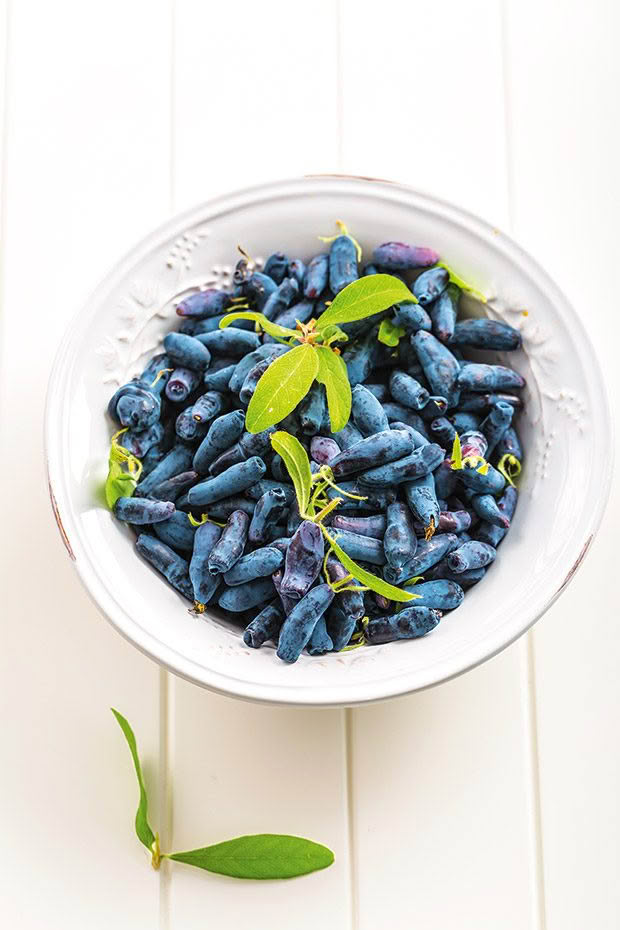
They’re the colour of a blueberry, have the sweetest name, and some of NZ’s most experienced croppers are hoping they’ll be an exciting new superfood for NZ gardeners and growers.
Words: Nadene Hall
Tucked away in a corner of nurseryman John Thirkettle’s retirement orchard, between the feijoas and the oranges, are around 2500 bushes that few people have ever seen.
The young honeyberry plants are part of an ambitious project that could create the next big superfood crop for NZ. Or maybe not.
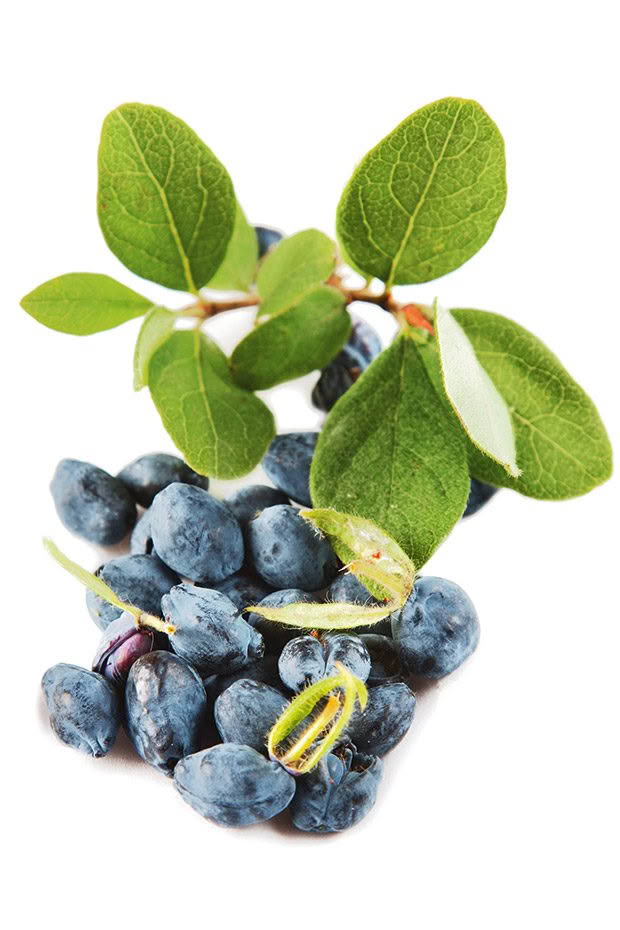
Russian honeyberries look more like rat droppings (see above). The NZ team is planning to develop more cylindrical or spherical berries like these ones.
“It’s a real lottery,” says John. “You’d be lucky to get 1-10 plants that are worthwhile growing out of 100 seeds, and that’s pretty good. We’ve got about 800 plants in one block, and about 1600 in another, so there’s a reasonable chance we might get something out of it.”
John is part of an NZ Tree Crops Association team which has spent the last few years working to create a bank of honeyberry plants. Some of these will become the ‘mother stock’ of new varieties that they’re hoping to develop to suit New Zealand’s various growing conditions.
If honeyberries work as a crop, they could offer a big opportunity to NZ growers, and home gardeners wanting a health boost.
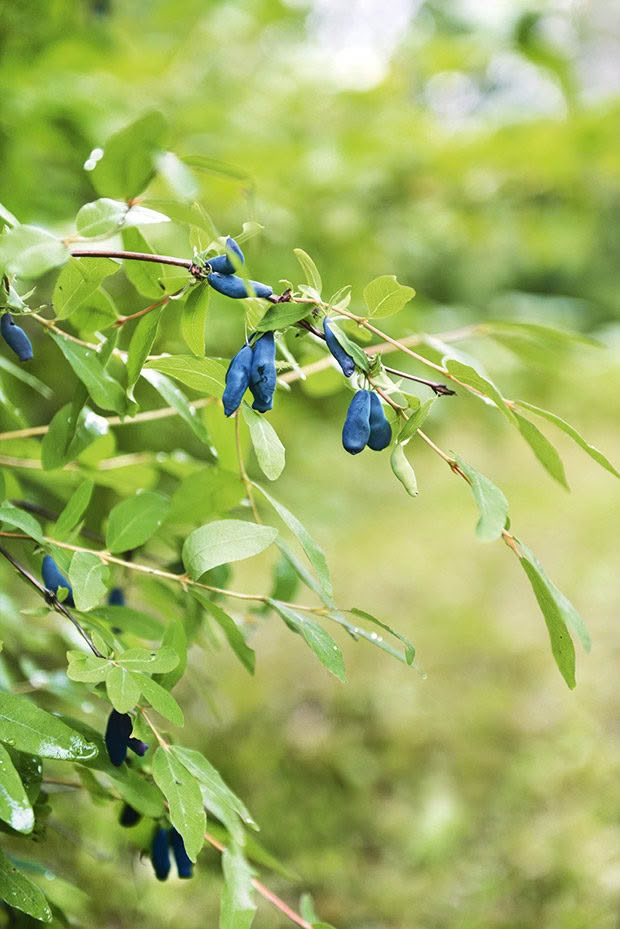
Some describe the taste as a mix of raspberry, blueberry, and blackberry.
The berries are very high in antioxidant compounds such as anthocyanins, substantially more than the better-known blueberry (see table below). They can be eaten fresh or turned into wine, preserves, nutritional supplements, and possibly pharmaceuticals. Another bonus is they ripen far sooner than blueberries, as early as November depending on the plant.
Then there’s the flavour. Some describe it as a mix of raspberry, blueberry, and blackberry. Others say there are hints of cherry, grape, kiwifruit, but almost everyone agrees it’s unique.
Jackie Thirkettle was initially underwhelmed. She’s one of the few people in NZ who has tried fresh, commercially-grown fruit at a honeyberry industry conference in Canada.
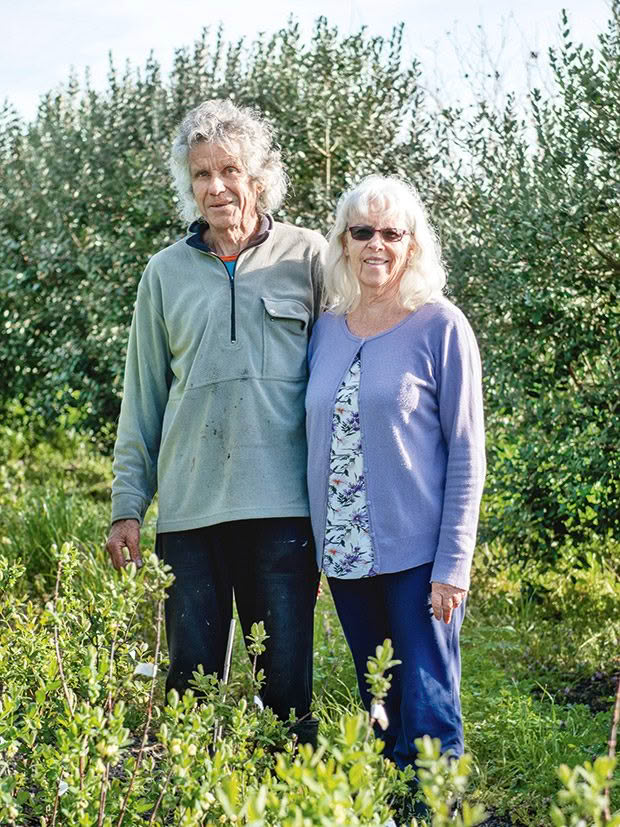
John and Jackie Thirkettle.
“After hearing all this hype about them, we went to a trial plot. We were going around tasting them, and I just couldn’t understand what they were all excited about. They tasted ok, but didn’t seem to be that outstanding to me.
“One of the last field trips was to an orchard further north… and they were really late harvesting. I tried some of those berries, and they were fantastic. Some people have said it tastes like a blackcurrant, but it doesn’t – they were sweet and had far more flavour than a blueberry.
“It all very much comes down to the fruit being ripe. There’s a massive difference between trying it on day one (of blueness) and say two or three weeks later when they fall off (the branch). That’s probably their prime sweetness.”
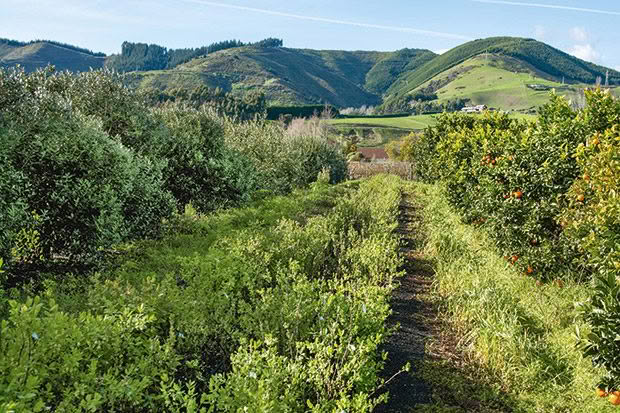
The honeyberries in the Thirkettle’s orchard are one to two years old.
The idea to develop honeyberry varieties for NZ first germinated in the mind of renowned plant scientist, Roy Hart. You’ve almost certainly gorged yourself on some of the trees he’s developed, such as feijoa varieties Pounamu, Kapapo, Anatoki, and Kakariki.
Roy is retired, but he’s still intrigued by tree crops. He’s also friends with one of the world’s top breeders of honeyberries. US nurseryman Jim Gilbert coined the name ‘honeyberry’. He was also one of the first westerners to head deep into Russia to find plants after the Cold War ended.
Roy brought the odd-looking, highly nutritious berry to the attention of his colleagues in the NZ Tree Crops Association.
“I certainly got quite excited,” says Eric Cairns. He’s a Tree Crops veteran, an expert in farm forestry, and the man who literally wrote the book on growing figs in NZ. He’s heading the honeyberry development team, growing trees, collating data, and helping to co-ordinate with Roy, John, and Jackie.
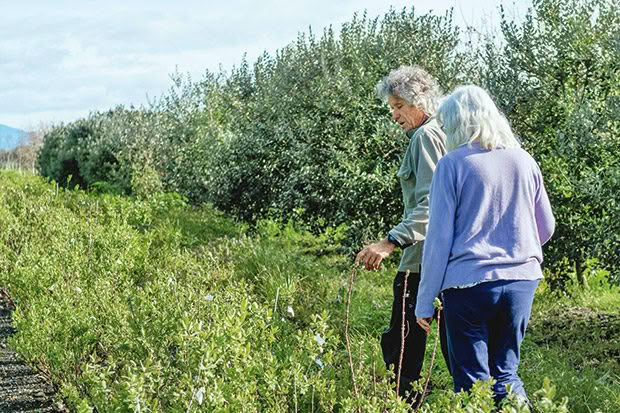
“It’s a very rare opportunity, that a crop amenable to a cool temperate climate, a brand-new crop that the west hasn’t heard of, comes on-stream. It’s so exciting.”
Wild honeyberries have been harvested in their native western Russia, northern China, and northern Japan for centuries. The Russians began creating commercial varieties that could handle the cold, short growing seasons of Siberia about 60 years ago.
The Japanese eat varieties native to Hokkaido and the Kuril Islands, north of Japan. There, it’s known as the haskapu, or ‘the berry that brings long life and good vision’, and the ‘little gift on the end of the branch’.
There were a small number of plants in NZ when the project began. The Tree Crops team know of two others who are trialling honeyberries on a similar scale and are working with one of them, near Dargaville.
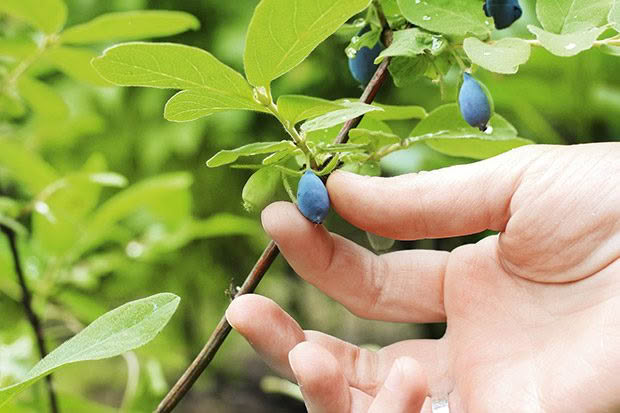
But this kind of work has risks. It was almost over before it began. A few years ago, MPI Biosecurity became convinced the plant hadn’t been in New Zealand before 1995. That’s the year new regulations came in that would have prevented it being grown if it wasn’t in NZ before then.
“They confiscated plants from one of the growers and destroyed them before other people were able to prove these things have been here for a while,” says Eric. “The NZ Alpine Garden Plant Society had it listed in its catalogues before 1995. (Exotic plant breeder) Bernard King had supplied them to an Auckland nursery too.”
Most of the Tree Crops trial trees are from seeds gifted by Jim Gilbert and Professor Maxine Thompson, the USA’s foremost expert on honeyberries. Tree Crops also imported seeds from Japan and suppliers in Europe.
Turning them into varieties that will grow well and produce good fruit in NZ’s varying climates is a massive challenge, even for these experienced growers.
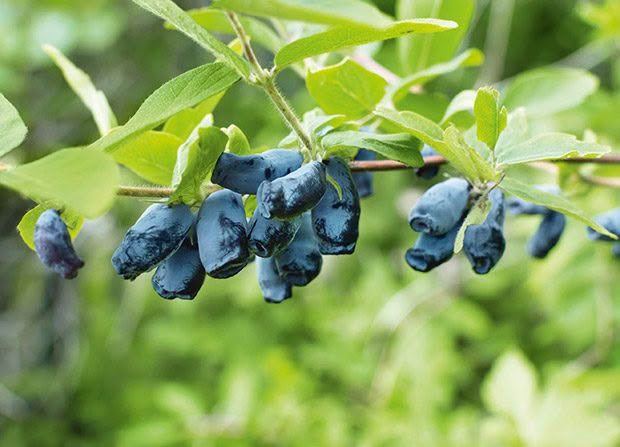
“Importers might choose to bring in cuttings or tissue culture as cloned varieties (exact genetic copies of the mother plant),” says Eric. “But changes to biosecurity regulations now require a minimum of six months in Level 2 quarantine.”
That process can cost $40,000-$50,000, something the volunteer Tree Crops team can’t afford. Using seeds means it will take a few more years, but it’s much cheaper, says Eric.
“Seed import doesn’t require a quarantine process, but resulting seedlings will not be exactly like the mother plant. We expect that fewer than one percent of seedlings will be good enough to register as new varieties.”
John and Jackie volunteered to grow the precious honeyberry seeds at Thirkettle’s Nursery, 20 minutes south-west of Nelson.
“When we got the first seeds, we grew them like we normally do – we grow thousands of seedlings every year – but then it looked like the poor things had died off,” says Jackie. “We were thinking ‘oh no, we’ve killed these precious babies’, but they all came back into leaf which was amazing. Then we potted them on as we normally do, put them outside, but we didn’t get the growth we expected.
“When I went to Canada, I saw what they do. They use heat, so once you do your pricking out, you grow them under plastic for that first period and you get really good growth, then you plant them outside.”
All the seeds are from ‘improved’ stock. These varieties have been bred over the last few decades, a mix of Japanese and Russian genetics.
“They’re quite robust plants,” says John. “They’ve got really tough root systems, so once you get them up to a 10cm pot, it’s difficult to kill them. But I don’t think they’ll be a weed pest – if there was a risk of them becoming a pest, they certainly would have sent up a red flag by now.”
“They seem to be pretty disease-resistant too,” says Jackie. “And we had a massive drought in Nelson in February 2019, and we couldn’t get water onto some of our crops. It looked like we may have lost them, but they sprouted back so they must be pretty damn hardy.”
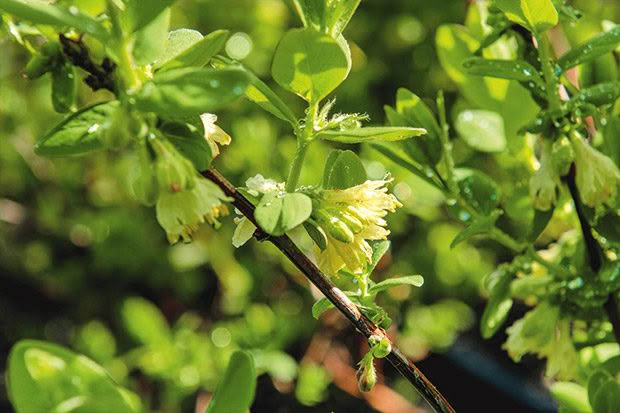
Some of the honeyberries began flowering in July. Others took until mid-September to bloom. Finding plants that flower at just the right time is one of the factors John, Roy, and Eric will look at when they select the best of the best to propagate. Every plant will be scrutinised, but things don’t have to be very wrong before an individual tree doesn’t rate.
“You don’t want to be overwhelmed with data so what you’re looking for are the winners,” says Eric. “We’re looking for vigour in a bush, heavy crop, good flavour, big berries, 2-3g. Then subtleties such as pickability – does it lend itself to machine harvesting?
“There’s shape too. A lot of the Russian-bred honeyberries are quite cylindrical and sort of look like a rat dropping, and we think they possibly ripen a bit quicker. In other areas the fruit is rounder.”
Then there’s the acid-sugar balance of the berries. High acid and tannin levels will suit winemakers, but be too sharp-tasting for home gardeners.
Another significant factor will be the winter chill requirements. If a plant doesn’t get cold enough for long enough during winter, it won’t get the signal to burst into flower at the right time. If the timing is wrong and flowering is too early, the flowers or young fruit may be killed off by a big spring frost or prolonged cold temperatures.
Honeyberry varieties in Canada, Japan, and Russia tolerate freezing temperatures and deep snow. Finding varieties that suit NZ’s far more temperate climate adds another level of complexity to the work.
“We don’t know what the issues are with honeyberry,” says Eric. “Flowers are hardy to –7°C, so they’re remarkably frost hardy. For really frost-prone sites, selecting the later flowering varieties may help.”
Most of the trees won’t make it through the mother stock selection process, but Eric and John are hopeful those trees won’t go to waste. They’re waiting to see if the Tree Crops management team will allow for some or all the trees to be dug up and sent out to members around NZ.
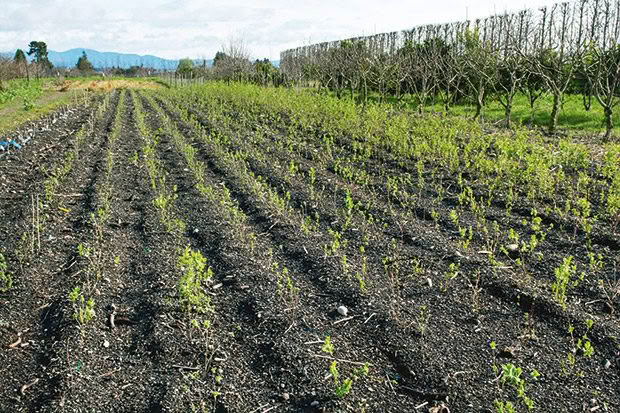
“We’re hoping to be able to find homes for those plants so we can pick some fruit and do experiments,” says Eric. “Can you dry them? How can you use them for processing? Where will they fit into the food industry?
“Honeyberries have a limited shelf life as they’re quite juicy and they bleed a bit. They’re not quite as good as blueberries. They’re not really built to ship around the world like blueberries – their modern cultivars have a very thick skin and can bounce around and don’t leak.”
Honeyberries can take three to four years to begin producing. Many of the young plants growing at Thirkettles fruited last year and will be fruiting again about now.
“There’s the anticipation, the expectation, that somewhere in there, we’ll be able to find ones of a good size and good flavour,” says John. “Looking through the 2000-odd plants to get them is our biggest challenge. Finding the elusive ones that are going to cut the mustard and make it to market.”
WHEN WILL HONEYBERRIES BE AVAILABLE IN NEW ZEALAND?
NZ Tree Crop members will be able to grow honeyberries over the next couple of years if chosen to be part of the trials. The rest of us will have to wait.
The Tree Crops team believe it will be around four to five years before they can develop varieties reliable enough to be sold in retail stores. And that’s a best-case scenario says Eric Cairns.
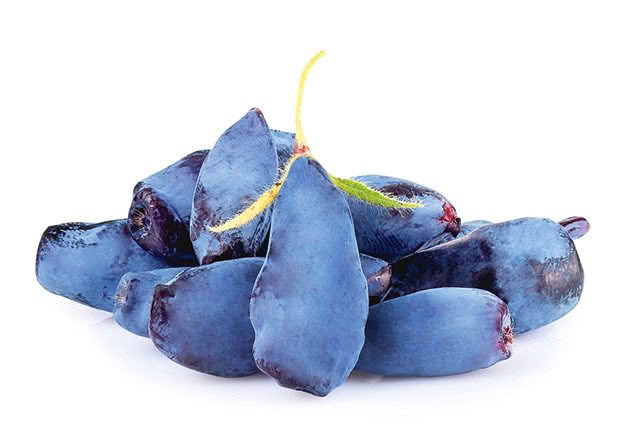
“We’ll make selections, and in autumn (2020) Thirkettles will propagate them. Some small plants might go out to trial next spring, but it’s more likely it would be a year later (2021). Then they’ve got to get big enough to flower so it’s a couple of years before people are getting data back. Then you’ve got to have enough to propagate again.”
Eric estimates the team will need to develop 10-20 different varieties to cover the seasons, pollen compatibility, flavour, and pickability requirements. Home garden selections will take priority.
“Then we’ll need more serious, larger-scale trials to measure yield and machine pickability for commercial varieties, and that will take a lot longer.
“We want people to be able to make informed choices between say growing blackcurrants, blueberries, or honeyberries. How profitable is it going to be? We haven’t got any of that data yet.”
HOW TO HARVEST HONEYBERRIES
You don’t pick honeyberries when they turn a gorgeous blooming blue.
It takes about 10-21 days from the time they first turn blue until they are at peak sweetness. Ripe ones fall from the branches, so commercial growers in Canada and the US use agitators that gently shake the tree, then collect the fallen berries.
Home gardeners in the US cut small, hard plastic paddling pools in half and place them under the tree or lay down plastic or tarpaulin sheets. They then shake the trunk or whack it with a broom handle.
THE LOWDOWN
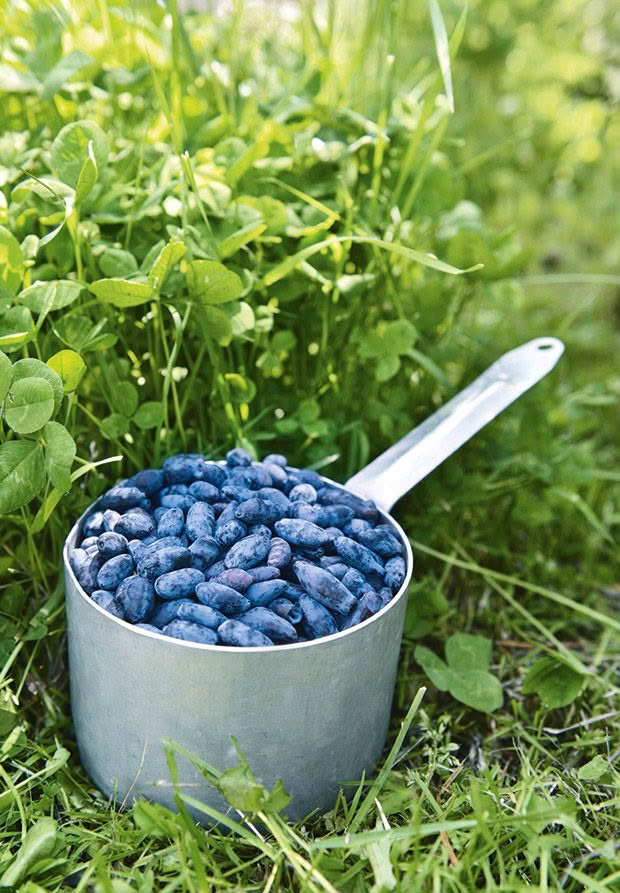
What: Honeyberry, Lonicera caerulea, a non-climbing honeysuckle, also known internationally as haskap (from its Japanese name, haskapu) and blue honeysuckle
Why: super-high levels of antioxidants, good flavour, fruits far earlier than blueberries and even some strawberries (depending on the plant)
Origin: northern Asia-southern Russia
Size: bush, can be hedged
Soil: tolerates most soils, including acidic, but does best in free-draining loam, pH 6.0-6.5
Pests & diseases: very hardy, no pest or disease issues yet in NZ but birds will strip berries
Flowers: yellow-white flower, August (range July-September, depending on the plant)
Pollination: not self-fertile, at least two different varieties with similar flowering times are required
Fruit: blue skin; varies in shape from almost round to oval, to long and pinched depending on the origin of the plant; vibrant blue-purple flesh, seedless; possibly 1.5-3g (versus the average 1g blueberry)
Harvest: early November-early December (depending on the plant)
Flavour: when ripe, a cross between a raspberry, blueberry, and blackberry, very sweet with a zing; some varieties have a naturally higher acid/more tart taste
Uses: fresh fruit, jam/preserves, wine, juice, cordials, drinks, flavouring, nutraceuticals, pharmaceuticals
CHALLENGES
The team working on growing honeyberries for NZ face a range of challenges:
■ developing varieties that do well in NZ’s varying conditions, especially climate, but plants are currently growing as far north as Dargaville, and as far south as Nelson;
■ finding good options to suit the needs of home gardeners and commercial growers;
■ how to best protect crops from birds.
FRUIT NUTRIENT COMPARISON TABLE (PER 100g)
1. Honeyberry
Potassium: 190mg Calcium: 38mg Phosphorus: 25mg Iron: 0.6mg Vit A: 130ug Vit C: 44mg Vit E: 1.1mg Energy: 53kcal
2. Blueberry
Potassium: 70mg Calcium: 8mg Phosphorus: 9mg Iron: 0.6mg Vit A: 0.0ug Vit C: 10mg Vit E: .6mg Energy: 49kcal
3. Grape
Potassium: 130mg Calcium: 6mg Phosphorus: 13mg Iron: 0.2mg Vit A: 15ug Vit C:4mg Vit E: 0.3mg Energy: 56kcal
4. Orange
Potassium: 130mg Calcium: 17mg Phosphorus: 12mg Iron: 0.1mg Vit A: 60ug Vit C:35mg Vit E: 0.4mg Energy: 39kcal
Source: Science and Technology Agency Resource Council, Japan
TOTAL ANTHOCYANIN CONTENT IN FRUIT, FRESH WEIGHT, PER 100g
Anthocyanin is a type of flavonoid which is high in antioxidants. It’s also the pigment that give red, purple, and blue plants their rich colouring.
honeyberry: 1300.00
raspberry :22.2 – 436.9
blackberry: 125.6 – 152.2
red currant: 1.4 – 7.8
blueberry: 99.9
Source: Haskap Berries (Lonicera caerulea L.) – a Critical Review of Antioxidant Capacity and Health-Related Studies for Potential Value-Added Products, 2014
Love this story? Subscribe now!
 This article first appeared in NZ Lifestyle Block Magazine.
This article first appeared in NZ Lifestyle Block Magazine.
